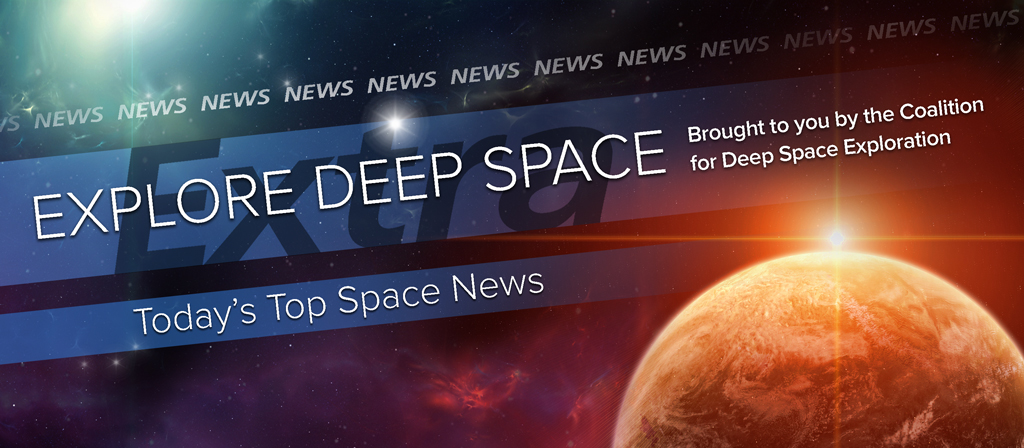In Today’s Deep Space Extra… U.S. President’s proposed NASA budget would trim spending on human exploration systems, robotic mission to Europa.
Human Deep Space Exploration
NASA packs a big vision for space exploration into smaller $19 billion budget
Geekwire.com (2/9): The White House faces likely opposition from Congress over the proposed $19 billion NASA spending plan for 2017 presented to lawmakers by President Obama on Tuesday. Three hundred million dollars less than the 2016 spending plan, investments in the Space Launch System exploration rocket and Orion crew exploration capsule, decline. The 2017 proposal includes $8.4 billion for exploration systems and operations, down from the $9.06 billion included in 2016 to develop the hardware and strategies for reaching Mars with human explorers in the 2030s.
White House proposes $19 billion NASA budget
Space News (2/9): Proposed cuts in NASA’s exploration development program outlined in President Obama’s proposed NASA budget for 2017, drew concern from two groups, industry and congressional overseers on Tuesday. “This proposed budget falls well short of the investment needed to support NASA’s exploration missions,” said Mary Lynne Dittmar, executive director of the Coalition for Deep Space Exploration. “This imbalanced proposal continues to tie our astronauts’ feet to the ground and makes a Mars mission all but impossible,” said Lamar Smith, chair of the U.S. House Science Committee.
NASA FY2017 budget request sets up familiar battles with Congress
Spacepolicyonline.com (2/9): President Obama’s 2017 budget proposal cuts three NASA programs considered congressional priorities, two of them — the Space Launch System exploration rocket and Orion crew capsule — are considered crucial to the agency’s human deep space exploration ambitions, including missions to Mars in the 2030s. Spending dips as well for a robotic mission to Europa, the ice and ocean covered moon on Jupiter, which some scientists believe may harbor habitable environments.
Last Obama budget said ‘strangling’ NASA’s Space Launch System
Huntsville Times (2/9): Cuts to NASA’s Space Launch System heavy lift rocket in the 2017 budget proposed by the White House on Tuesday could jeopardize U.S. human deep space exploration plans, according to some in Congress. Todd May, director of NASA’s Marshall Space Flight Center — where the SLS is under development, urged patience as negotiations over spending begin. “We’ve got plans laid out for the rest of this year, and we’re moving out,” said May. “We’ll just see where it ends up.”
Cabana: Proposed NASA budget ‘great’ for KSC
Florida Today (2/9): Robert Cabana, director of NASA’s Kennedy Space Center, sizes up the proposed NASA budget for 2017. The spending plan should permit the space agency to continue the development of exploration systems that will send humans on future missions of human deep space exploration and restore a U.S. capability to launch astronauts by 2017 on rockets developed by Boeing and SpaceX under NASA’s Commercial Crew Program, says Cabana.
Space Science
Planets with too much carbon dioxide could lose oceans to space
New Scientist (2/9): Rising CO2 concentrations in the Earth’s atmosphere could rival natural increases on solar radiation as threats to water concentrations on the Earth, according to scientists who pursued numerical modeling of the two factors.
Hundreds of galaxies found hiding behind Milky Way
Discovery.com (2/9): Hundreds of previously obscured star systems lurk behind the Milky Way, according to Australian astronomers using a radio telescope observatory.
That wasn’t a meteorite that killed a man in India, NASA says
New York Times (2/9): Experts question reports that a meteorite was responsible for the death of an Indian man, a bus driver, who died of injuries on a college campus on Saturday.
Medium-size asteroid strike could unleash a mini ice age
Space.com (2/9): A blow from a medium sized asteroid, less than a half mile wide, could plunge the Earth into an ice age like environment, causing sharp drops in precipitation and vegetation, according to a researcher from the National Center for Atmospheric Research, of Colorado. Grim conditions could span several years.
Low Earth Orbit
Retired Nebraska astronaut Clayton Anderson tells Kearney students: I applied to NASA 15 times, so don’t give up
Omaha.com (2/9): Retired NASA astronaut Clay Anderson urged students at Park Elementary School in Kearney, Neb., earlier this week to persevere as they pursue their life’s ambitions. Anderson applied 15 times before his selection to serve as an astronaut between 1998 and 2013. Anderson made two trips to orbit.
Commercial to Low Earth Orbit
White House requests $1.2 billion for new rocket in Air Force budget
Space News (2/9): The U.S. Air Force intends to invest $1.2 billion in new domestic rocket systems intended to replace those that rely on controversial Russian imports of the RD-180 rocket engine, according to documents provided to lawmakers as part of President Obama’s proposed 2017 spending plan. New launch services would place U.S. national security payloads into orbit.
Suborbital
Blue Origin’s challenge: Be a start up in a traditional industry
Orlando Sentinel (2/10): Within months, launch services start up Blue Origin plans to break ground on a $200 million factory and launch site on Florida’s Space Coast, bringing 300 new jobs. The company’s challenge will be to merge into a long standing industry in the region, while sustaining a lean and agile persona, according to a top executive for the company in Florida.

